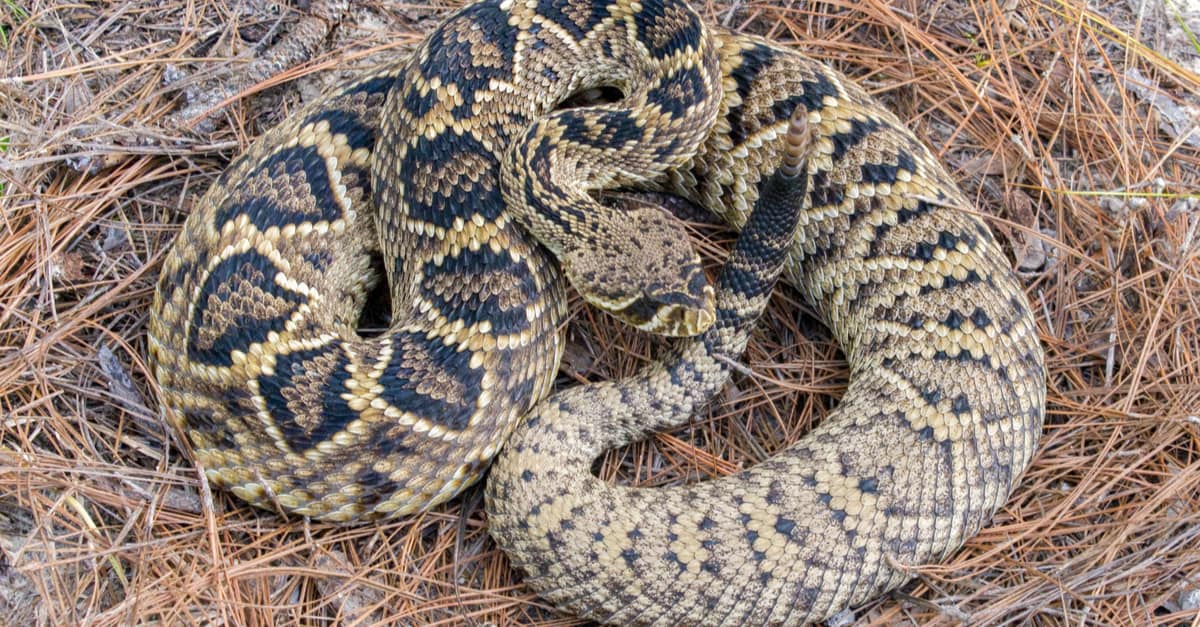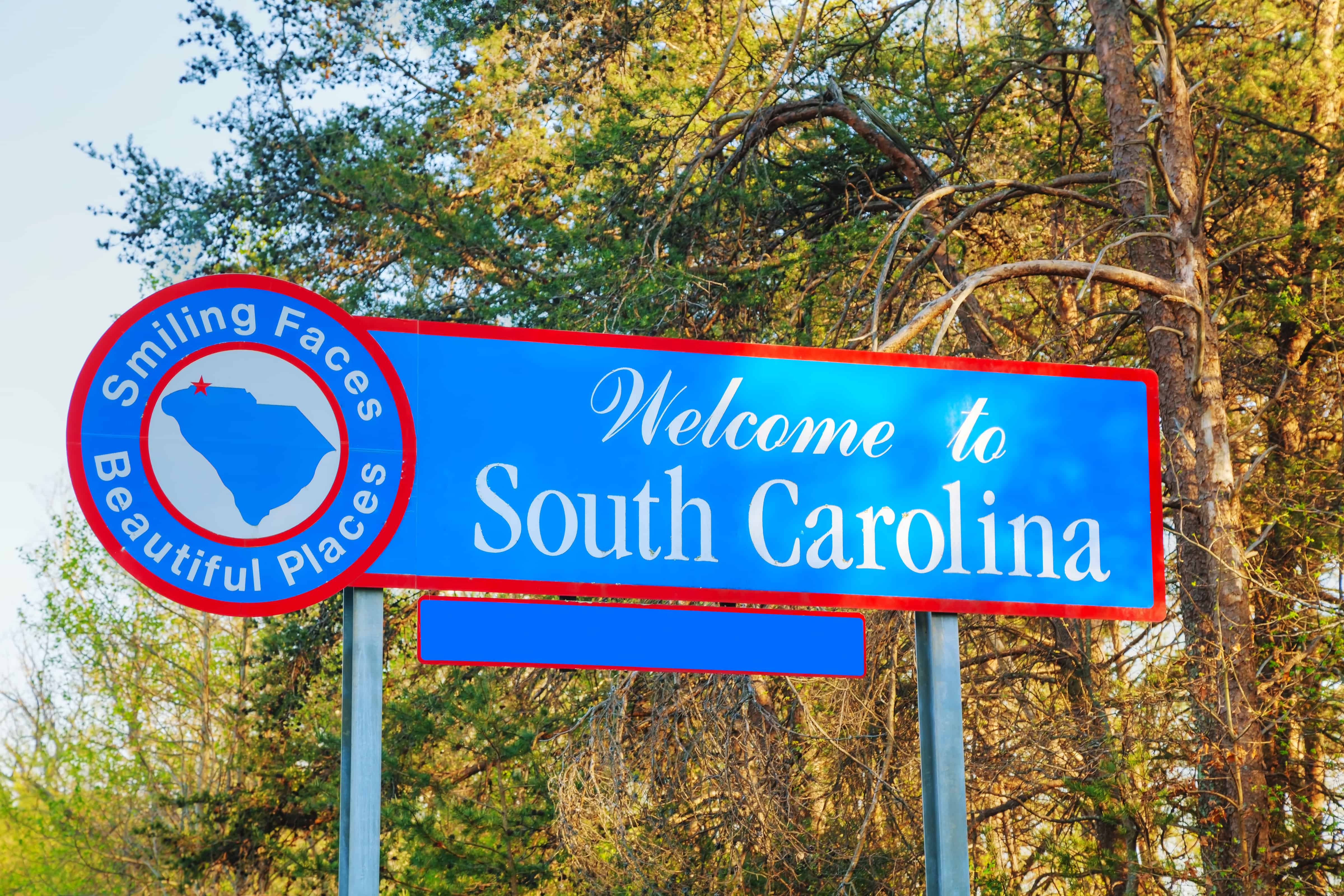
South Carolina has a hot and humid climate combined with vast expanses of grasslands and wetlands, which makes it a haven for snakes.
©photo.ua/Shutterstock.com
When you think of South Carolina you probably don’t think of snakes. But you should. South Carolina’s hot and humid climate combined with vast expanses of grasslands and the famous marshy wet landscape of the Low Country make it a haven for snakes of all kinds. This state has one of the largest varieties of native snakes with 38 different species of snakes that live there. South Carolina also has a lot of venomous snakes that you should know so that you will be able to identify them and keep yourself safe when you’re enjoying all that South Carolina has to offer.
Common Snakes In South Carolina
There are a lot of snakes in South Carolina. That can be a little intimidating to people who are afraid of snakes, but the snakes in South Carolina have an important purpose. They help control the state’s population of pests and insects and make it easier for farmers to protect their crops.
Let’s take a look at some of the more common non-venomous snakes that live in the Palmetto State. None of these snakes pose much harm and as you’re out and about you may see them across the state’s forests, grasslands, and lowland areas!
Corn Snake

Corn snakes are most active from March to November.
©Kurit afshen/Shutterstock.com
| Corn Snake | |
|---|---|
| Lenth | Maximum of 6 feet in length |
| Location in State | Found across all regions of South Carolina |
Corn snakes live on the outer edges of forests and fields. They are large snakes that typically measure over four feet long. Corn snakes stand out because of their bright red-orange coloring and even if they’re hiding in the tall grass near the edge of a field you will easily be able to see them. These snakes are a type of rat snake (they’re sometimes called the red rat snake) and they feed on the rodents that like in the grass fields. Corn snakes also are great climbers so you should always look up when you’re walking along the edge of a South Carolina field that borders a forest because there may be a corn snake above your head as well as under your feet.
Black Racer Snake

The black racer is an agile and very fast animal that can “run” (crawl) 4 miles per hour when it is threatened, hence the name “racer”.
©Breck P. Kent/Shutterstock.com
| Black Racer Snake | |
|---|---|
| Lenth | Maximum of 6 feet in length |
| Location in State | Found most often next to the edges of wetlands and forests |
Black racer snakes are among the most common snakes in South Carolina. They look a little scary because they are long and black, but they are harmless to people. They are also very fast and try to avoid people when possible. These snakes can move at speeds up to four miles per hour so chances are that if you see a Black Racer what you’re going to see is just the snake moving away from you at a high rate of speed. Black Racers are commonly seen on back roads and on walking paths around the state. If you do see one just stop for a minute and it will most likely flee.
Yellow Rat Snake
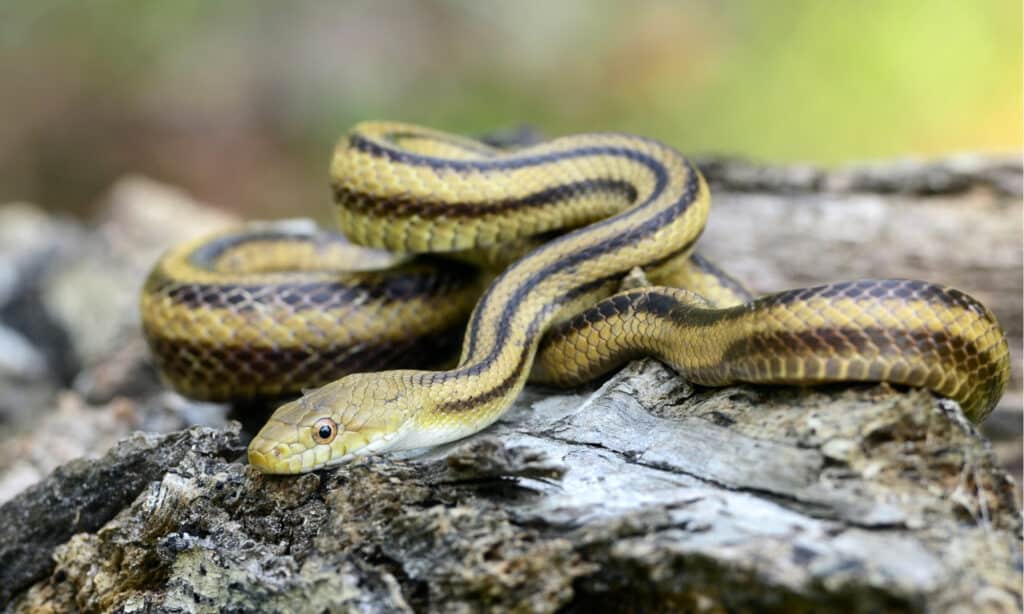
©Patrick K. Campbell/Shutterstock.com
| Yellow Rat Snake | |
|---|---|
| Lenth | Maximum of 8 feet in length |
| Location in State | Coastal regions |
Yellow rat snakes are found only along the South Carolina coast. Like other types of rat snakes, they have a bad reputation but they are actually very beneficial to people because they kill the rodents and small mammals that eat and destroy crops. Yellow rat snakes have a brownish-yellow to golden-yellow color and have thin brown stripes. While rat snakes have been recorded growing as long as eight feet in length, they’re more commonly about four to six feet long.
Eastern Mud Snake
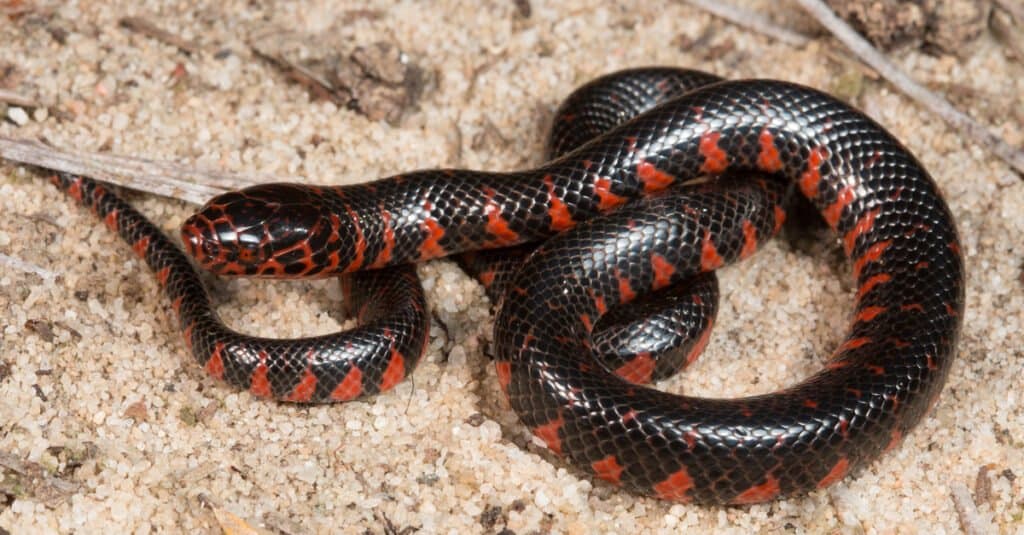
Mud snakes can reach long lengths but don’t pose a threat to people.
©Nathan A Shepard/Shutterstock.com
| Eastern Mud Snake | |
|---|---|
| Lenth | Maximum of 7 feet in length |
| Location in State | Low Country and coast |
The Eastern mud snake is another snake that looks very scary but really is no threat to people. This non-venomous snake lives in the water and is primarily found along the coast or in the Low Country. Eastern Mud snakes are long. They can be up to a whopping 85 inches long. The snake’s primary color is glossy black and they have bright red markings.
Eastern Ribbon Snake

Ribbon
snakes and garter
snakes are closely related.
©Steve Bower/Shutterstock.com
| Eastern Ribbon Snake | |
|---|---|
| Lenth | Maximum of 3 feet in length |
| Location in State | Found across all regions of South Carolina |
Eastern ribbon snakes are related to garter snakes. They are very common across South Carolina. Even though these snakes are tiny and are often a foot or less in length, they have a big attitude. An Eastern ribbon snake may bite you if try to handle it or if it feels threatened but they are non-venomous so even if they bite you they aren’t dangerous. However, if you do get bitten by an Eastern ribbon snake you still should get medical attention to prevent the bite from getting infected.
Water Snakes in South Carolina
There are five different species of water snakes in South Carolina. Water snakes belong to the genus Nerodia, and there are 10 different species of water snakes (9 true water snakes) across the United States. Water snakes are at ease in aquatic environments and rarely venture far from still sources of water like streams, lakes, and swamps. Let’s look at a couple of water snakes you might find in South Carolina.
Brown Water Snake
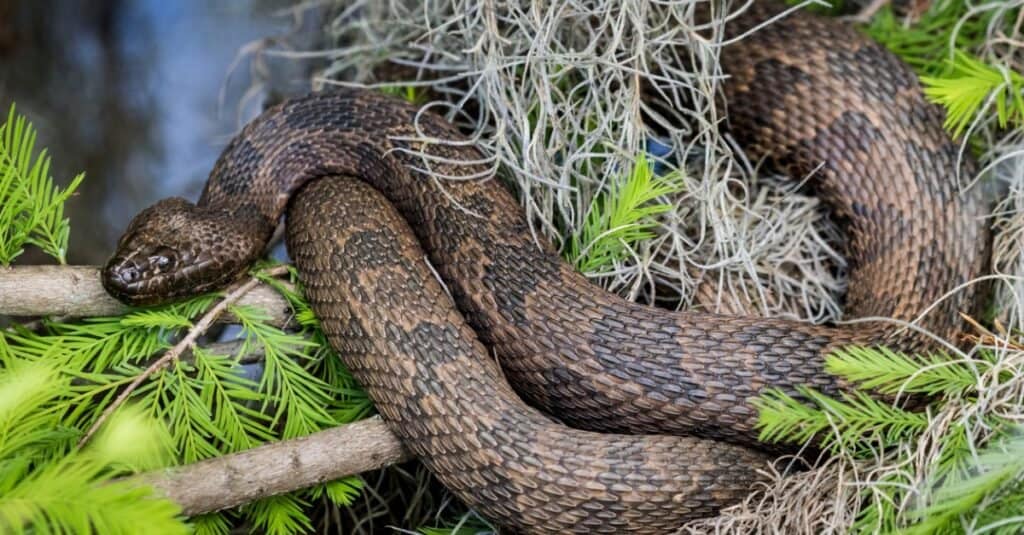
The dark brown patches on the back on larger than those on the side.
©iStock.com/csraphotography
| Brown Snake | |
|---|---|
| Lenth | Maximum of 6 feet in length |
| Location in State | Not located in upstate South Carolina |
Brown water snakes are generally about 30 to 60 inches in length but can grow to a maximum of 60 inches. They range from Virginia down to Louisiana along the Atlantic and Gulf coasts. In South Carolina, they’re found inland into the Midland region but are not found upstate. Like other water snakes, the brown water snake feeds primarily on fish. When not in the water hunting, they’ll often climb trees or bask in the sun near water sources.
Florida Green Water Snake
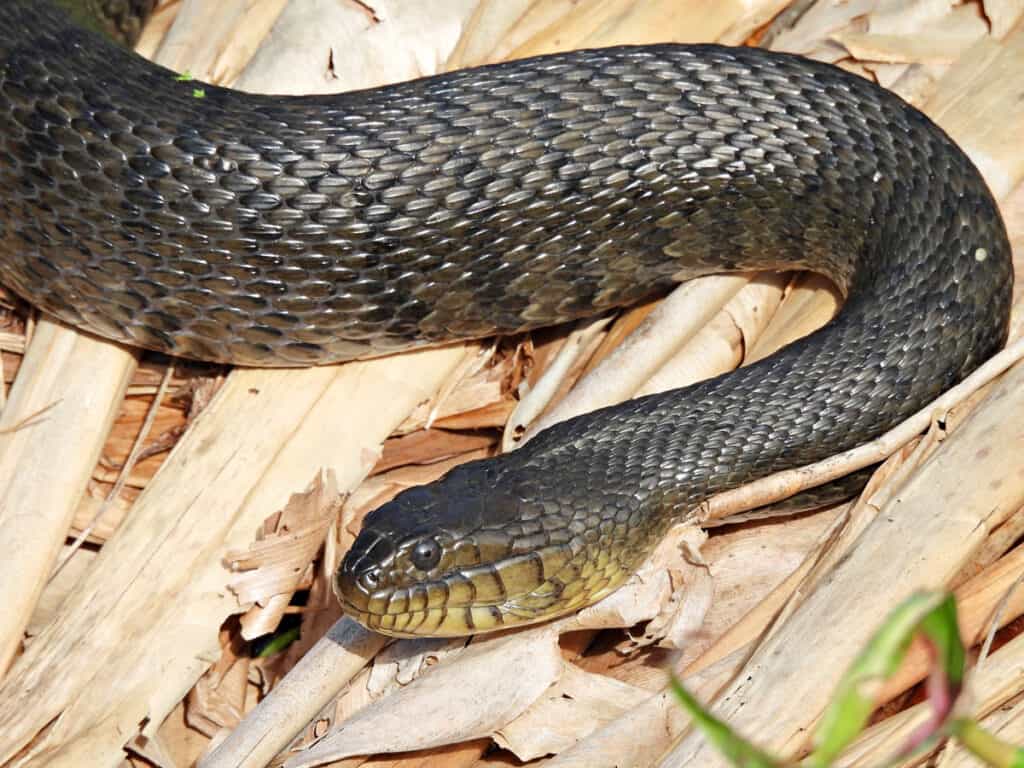
The Florida green watersnake can be found all over Florida and into nearby states like South Carolina. It has a distinctly large head.
©iStock.com/passion4nature
| Florida Green Water Snake | |
|---|---|
| Western and Southern South Carolina | Maximum of 6 feet in length |
| Location in State | Western and southern South Carolina |
Another largely aquatic snake that lives in South Carolina is the Florida green water snake. In South Carolina, green water snakes live exclusively in the Western and Southern regions of the state. These snakes generally range from 30 to 55 inches long and generally have either a red-brown body with black markings or an all-over dark olive-to-black body depending on what region they live in. Green water snakes can be aggressive and they do bite occasionally, but they are not venomous so they are not really dangerous. They can give you a nasty surprise though, so be careful when you are fishing, boating, kayaking, or doing other activities on the edges of marshes, ponds, and lakes.
Venomous (Poisonous) Snakes In South Carolina
South Carolina has six different types of venomous snakes which is a relatively high number of venomous snakes compared to other states. Some of the venomous snakes in South Carolina are:
Copperhead
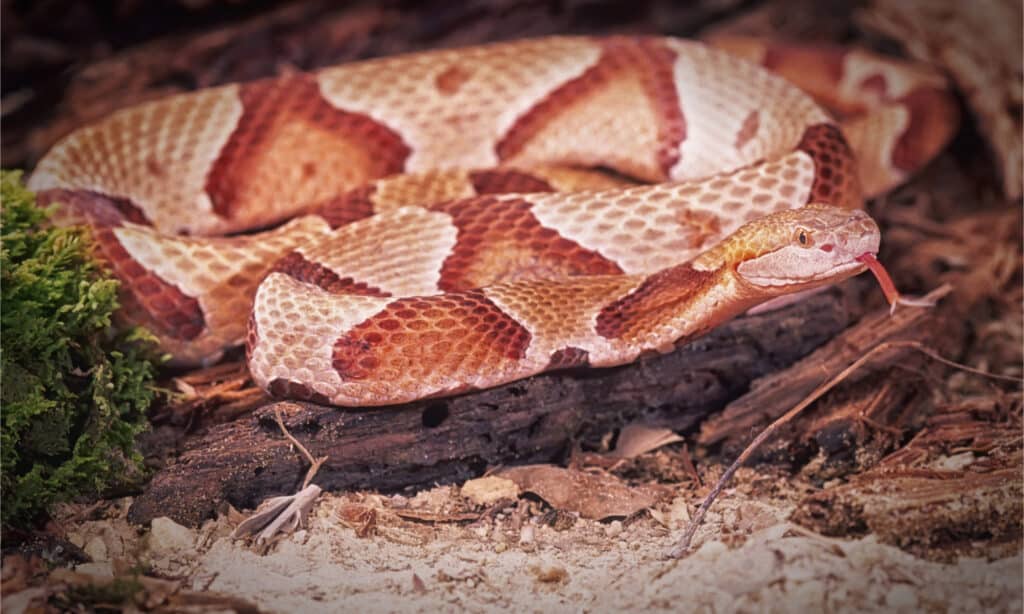
Copperheads are beautiful, but venomous! Fortunately, their venom isn’t as dangerous as their cousin the cottonmouth.
©outdoorsman/Shutterstock.com
| Copperhead | |
|---|---|
| Lenth | Maximum of 4 feet in length |
| Location in State | Found across all regions of South Carolina |
Copperheads are the most common venomous snake in South Carolina. They can be found all over the state so you should have your guard up whenever you hiking, biking, or engaging in outdoor activities in South Carolina. Copperhead snakes are only usually two to three feet long but they are very heavy and wide. Their colors vary based on the habitat they are in but they are usually orange, brown, or even pinkish-red with brown wide markings. While not aggressive by nature, the copperhead is responsible for more bits than any other venomous snake in the United States. Thankfully, the fatality rate of their bites is just .01%. If bit by a copperhead, make sure to seek medical attention. Most people bitten by these snakes are back to normal within 2 to 4 weeks.
Eastern Coral Snake

Coral snakes are a rare sight in South Carolina.
©iStock.com/JasonOndreicka
| Eastern Coral Snake | |
|---|---|
| Length | Maximum of 5 feet |
| Location in State | Found across coastal areas and into Carolina’s Midlands regions |
Eastern coral snakes live primarily in the sandy soil common along the South Carolina coast and in the Low Country area. Coral snakes have a particularly bright coloring that is a thick red stripe banded by thin stripes of yellow or white. Even though Coral snakes are venomous and you should never handle one in the wild they rarely are seen above ground so they are not a huge threat. These bright snakes prefer to stay buried in the sandy soil whenever possible. There has been just one death from a coral snake bite since the 1960s. It came from a Florida man who didn’t seek medical attention after getting bit.
Eastern Diamondback Rattlesnake
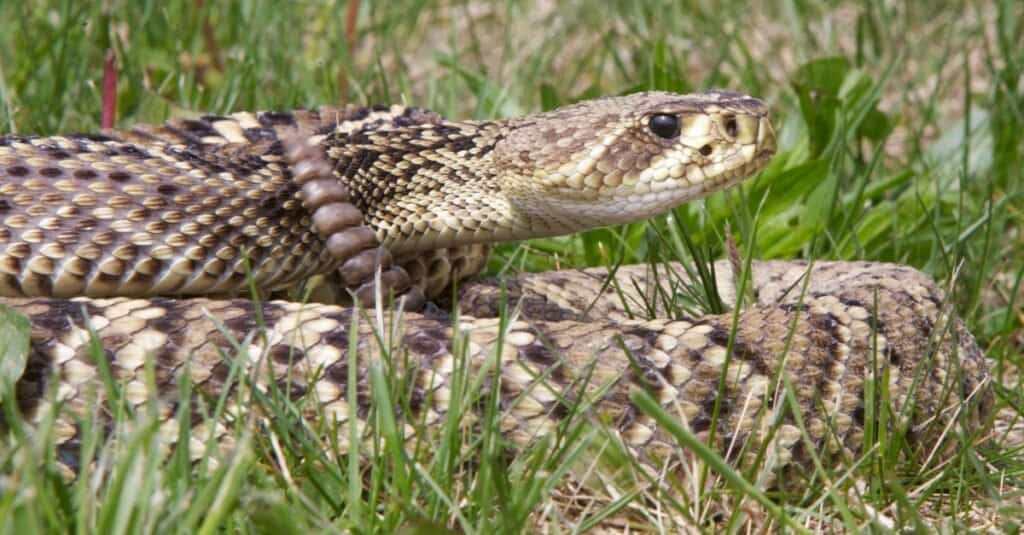
The Eastern diamondback rattlesnake was a symbol on one of the first flags of the United States.
©iStock.com/NajaShots
| Eastern Diamondback Rattlesnake | |
|---|---|
| Lenth | Maximum of 8 feet in length |
| Location in State | Found mostly across coastal regions |
Eastern diamondback rattlesnakes in South Carolina prefer to be on the coast where there are lots of sand dunes and plenty of sandy soil. Diamondback rattlesnakes are the largest venomous snakes in South Carolina. Some of them weigh in at more than ten pounds and stretch almost six feet. Exceptional eastern diamondbacks have been measured at up to 7 feet 10 inches, but diamondbacks over seven feet in length are rare. The Eastern diamondback rattlesnake isn’t a common sight in South Carolina, but if you’re having a beach day or spending time along the coast it’s smart to keep an eye out for these snakes.
Cottonmouth Snake
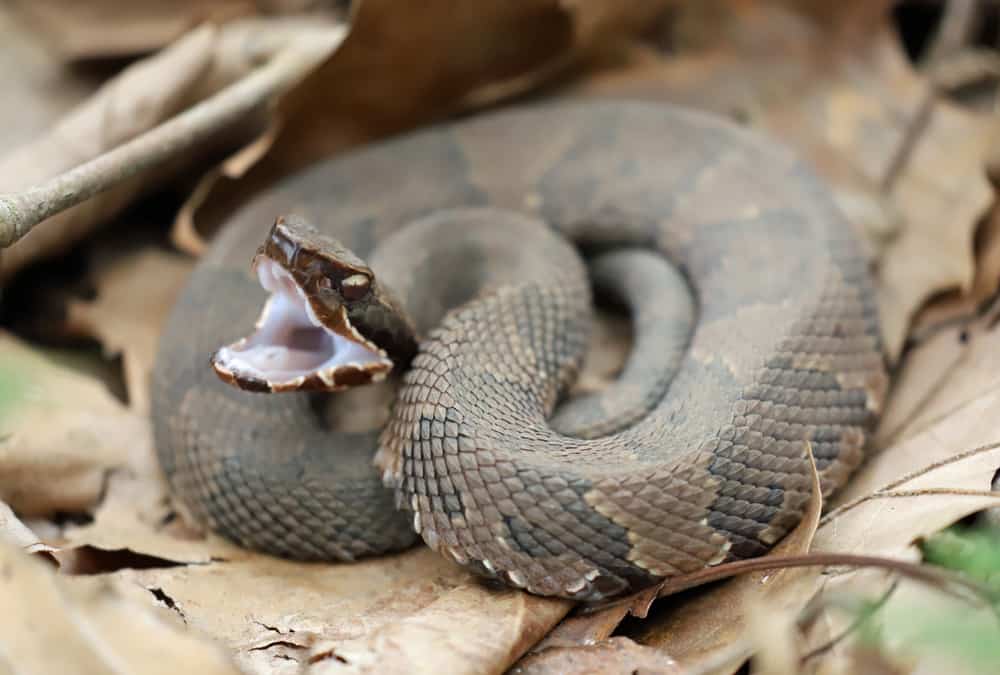
Cottonmouth snakes are venomous snakes that are mostly aquatic.
©KF2017/Shutterstock.com
| Cottonmouth | |
|---|---|
| Lenth | Maximum of 6 feet in length |
| Location in State | Found on coastal plains but rare in Piedmont |
Another venomous snake that prefers to live in the coastal area and among the sand hills in South Carolina is the cottonmouth snake. Cottonmouth snakes are easy to identify because they have a white patch underneath and inside of their mouths. They are also sometimes called water moccasins. Their coloring varies based on where they are. Cottonmouths can have a dark coloring with gray markings, or a dark coloring with reddish-brown markings, but their base color is almost always dark. Cottonmouths are at ease in the water and are mostly found near freshwater sources.
A Complete List Of Snakes In South Carolina
South Carolina has a large population of snakes, including six different types of venomous snakes. That means that when you’re enjoying some of the great fishing, kayaking, hiking, and other outdoor activities that South Carolina is known for you will likely be close to at least a few types of snakes.
Below, you’ll find a complete list of the snake species you can find in South Carolina. You’ll notice some snakes are grouped, that’s because there are both species and subspecies on this list. These can get confusing! For example, the scarlet king snake is a subspecies of the milk snake and is less closely related to other snakes named “king snake!” So while there are 38 species of snakes in South Carolina, there are 45 types of snakes when including these subspecies as well!
The complete list of all the different kinds of snakes in South Carolina is as follows.
Non-venomous Snakes
- Eastern Worm Snake
- Scarlet Snake
- Black Racer Snake
- Ring-necked Snake
- Northern Ring-necked Snake
- Southern Ring-necked Snake
- Corn Snake
- Rat Snakes
- Black Rat Snake
- Yellow Rat Snake
- Eastern Mud Snake
- Rainbow Snake
- Eastern Hognose Snake
- Southern Hognose Snake
- Mole King Snake
- Eastern King Snake
- Milk Snakes
- Scarlet King Snake
- Eastern Milk Snake
- Eastern Coachwhip Snake
- Redbelly Water Snake
- Banded Water Snake
- Florida Green Water Snake
- Common Water Snake
- Midland Water Snake
- Northern Water Snake
- Brown Water Snake
- Rough Green Snake
- Pine Snake
- Glossy Crayfish Snake
- Queen Snake
- Pine Woods Snake
- Carolina Swamp Snake
- Brown Snake
- Redbelly Snakes
- Florida Redbelly Snake
- Northern Redbelly Snake
- Southeastern Crown Snake
- Ribbon Snakes
- Peninsula Ribbon Snake
- Eastern Ribbon Snake
- Eastern Garter Snake
- Rough Earth Snake
- Eastern Smooth Earth Snake
Venomous Snakes
- Copperhead Snake
- Coral Snake
- Easter Diamondback Rattlesnake
- Cottonmouth Snake
- Timber Rattlesnake
- Pygmy Rattlesnake
- Dusky pygmy rattlesnake
- Carolina pygmy rattlesnake
Water Snakes in South Carolina
If you want to learn more about the water snakes in South Carolina, read the article at this link or click on the title below. Water snakes are semi-aquatic snakes from the genus Nerodia. There are nine species across North America, and five of them are found in South Carolina. Although many other snakes also inhabit water – such as swamp snakes and venomous cottonmouths (which live in South Carolina) – only snakes from Nerodia are classed as true water snakes. So join us as we learn all about the Northern, Banded, Brown, Florida Green, and Plain-bellied water snakes in South Carolina!
Summary of 6 Venomous Snakes Found In South Carolina
Here’s a summary of the 6 venomous snakes in South Carolina and where they can be found:
| Number | Snake | Location |
|---|---|---|
| 1 | Pygmy Rattlesnake | Often found near freshwater; rarely in the mountains |
| 2 | Timber Rattlesnake | Found both in the mountains and in the Piedmont-coastal region |
| 3 | Copperheads | Found across all regions of South Carolina |
| 4 | Eastern Coral Snake | Found across coastal areas and into Carolina’s Midlands regions |
| 5 | Eastern Diamondback Rattlesnake | Found mostly across coastal regions |
| 6 | Cottonmouth | Found on coastal plains but rare in Piedmont |
Discover the "Monster" Snake 5X Bigger than an Anaconda
Every day A-Z Animals sends out some of the most incredible facts in the world from our free newsletter. Want to discover the 10 most beautiful snakes in the world, a "snake island" where you're never more than 3 feet from danger, or a "monster" snake 5X larger than an anaconda? Then sign up right now and you'll start receiving our daily newsletter absolutely free.
Thank you for reading! Have some feedback for us? Contact the AZ Animals editorial team.

